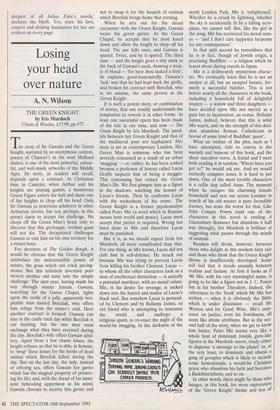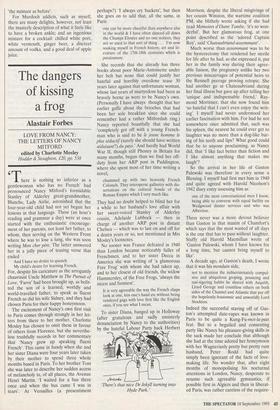Losing your head over nature
A. N. Wilson
THE GREEN KNIGHT by Iris Murdoch Chatto & Windus, £15.99, pp.472 The story of Sir Gawain and the Green Knight, narrated by an anonymous contem- porary of Chaucer's in the west Midland dialect, is one of the most powerful, colour- ful, and well-made artworks of the Middle Ages. Its story, as readers will recall, depends upon a contract. At Christmas time in Camelot, when Arthur and his knights are playing games, a monstrous Green Figure enters the hall and dares one of the knights to chop off his head. Only Sir Gawain (a notorious adulterer in other Arthurian stories, but not, perhaps, in this poem) dares to accept the challenge. He chops off the Green Man's head, only to discover that this grotesque, verdant giant will not die. The decapitated challenges Gawain to visit him on his own territory for a return bout.
For devotees of The Golden Bough, it would be obvious that the Green Knight symbolises the indestructible power of nature, the grass which can crack paving- stones. But this infinitely inventive poet weaves another old story into the simple challenge. The next year, having made his way through winter forests, Gawain, searching for the Green Chapel, lights upon the castle of a jolly, apparently hos- pitable man named Bercilak, who offers him refuge from the winter's cold. Here another contract is formed. Gawain can stay in the castle each day while Bercilak is out hunting, but the two men must exchange what they have received during the day. Bercilak's wife offers Gawain adul- tery. Apart from a few chaste kisses, the knight refuses, so that he is able, in honour, to `swap' these kisses for the hunks of dead animal which Bercilak killed during the day. But on the last day, the lady, instead of offering sex, offers Gawain her garter which has the magical property of preserv- ing his life; and, with the dread of his immi- nent beheading uppermost in his mind, Gawain chooses to secrete this garter and not to swap it for the haunch of venison which Bercilak brings home that evening.
When he sets out for the dread encounter with the Green Knight, Gawain wears the green garter. At the Green Chapel, he accepts that he must kneel down and allow the knight to chop off his head. The axe falls once, and Gawain is spared. Twice, and he is spared. The third time — and the knight gives a tiny snick to the back of Gawain's neck, drawing a trick- le of blood — 'for here thou lacked a little', he explains, good-humouredly. Gawain's `lack' was that he had kept back the girdle, and broken his contract with Bercilak, who is, we assume, the same person as the Green Knight .
It is such a potent story, or combination of stories, that one readily understands the temptation to rework it in other forms. At least one successful opera has been made of the tale in our time, and now — The Green Knight by Iris Murdoch. The paral- lels between her Green Knight and that of the mediaeval poet are haphazard. Her story is set in contemporary London. Her Green Man is someone who has been severely concussed as a result of an urban `mugging' — or, rather, he has been coshed because a professor of history called Lucas Graffe suspects him of being a mugger. This concussing has ruined the Green Man's life. We first glimpse him as a figure in the shadows, watching the houses of Lucas's friends. Then he confronts Lucas with the wickedness of his crime. The Green Knight is a former psychoanalyst called Peter Mir (a word which in Russian means both world and peace). Lucas must accept that justice is required. Wrong has been done to Mir and therefore Lucas must be punished.
But it is, as we should expect from Iris Murdoch, all more complicated than that. For one thing, as Mir knows, Lucas did not club him in self-defence. He struck out because Mir was trying to prevent Lucas from killing his brother Clement. Lucas to whom all the other characters look as a man of intellectual distinction — is actually a potential murderer, with no moral values. Mir, in his desire for revenge, is sucked down into the hatred and malice of Lucas's black soul. But somehow Lucas is persuad- ed by Clement and by Bellamy James, an old friend who is attempting to renounce the world and undergo a religious quest, to re-enact the night of the would-be mugging. In the darkness of the north London Park, Mir is 'enlightened'. Whether he is struck by lightning, whether the sky is accidentally lit by a falling aero- plane, we cannot tell. But, like the girl in the song, Mir has recovered his moral sens- es — 'and I don't care tuppence ha'penny for any consequences'.
In that split second he remembers that he is in fact, though of Jewish origin, a practising Buddhist — a religion which he learnt about during travels in Japan.
Mir is a deliberately mysterious charac- ter. We eventually learn that he is not an analyst at all, but an escaped lunatic, for- merly a successful butcher. This is not before nearly all the characters in the book, including a household full of delightful women — a widow and three daughters have decided upon Mir not merely as a guru but as incarnation, an avatar. Bellamy James, indeed, believes that this is what Mir was/is, and on the strength of this deci- sion abandons Roman Catholicism in favour of some kind of Buddhist 'quest'.
What an outline of the plot, such as I have attempted, fails to convey is the warmth and humour of this book, and the sheer narrative verve. A friend and I were both reading it in tandem. `Where have you got to?' he would ask me. And we would excitedly compare notes. It is hard to put down. One of the most lovable characters is a collie dog called Anax. The moment when he escapes the charming female household and sets out across London in search of his old master is pure Incredible Journey, but none the worse for that. Like John Cowper Powys (and one of the characters in this novel is reading A Glastonbury Romance but abandons it half way through), Iris Murdoch is brilliant at suggesting what passes through the minds of animals.
Readers will divide, however, between those who delight in this modern fairy tale and those who think that the Green Knight theme is insufficiently developed. Some will feel that it treads uneasily between realism and fantasy. At first it looks as if Mr Mir, with his very meaningful name, is going to be like a figure not in J. C. Powys but in his brother Theodore. Indeed, the references to the `book' which Mr Mir has written — when it is obviously the Bible which is under discussion — recall Mr Weston and his Good Wine. Mir's insis- tence on justice, even his Jewishness, all seem like divine attributes. But in the sec- ond half of the story, when we get to know him better, Peter Mir seems very like a whole host of dominant Jewish, guru-like figures in the Murdoch oeuvre, ready either to dispense `a message to the planet' or, at the very least, to dominate and obsess a gang of groupies which is likely to include some homosexuals, a would-be Christian priest who abandons his faith and becomes a Buddhist/atheist, and so on. In other words, there might be those who hunger, in this book, for more exploration of the 'Green Knight' theme and less of `the mixture as before'.
For Murdoch addicts, such as myself, there are many delights, however, not least the masterly description of what it feels like to have a broken ankle; and an ingenious mixture for a cocktail: chilled white port, white vermouth, ginger beer, a discreet amount of vodka, and a good deal of apple juice.



































































 Previous page
Previous page